Gaia Data Release 2 is here!
The data, released on April 25, are
available in the Gaia Science Archive and through ESASky
The long-time awaited Gaia Data Release 2 is
finally available in the Gaia Science
Archive from April 25, 2018. Users can also query the
main catalogue through ESASky.
Both services feature new or improved functionalities to make
the exploration and retrieval of the data easier and more
efficient.
This data release provides positions, parallaxes and proper
motions for more than 1.3 billion stars between G-magnitudes 3
and 21; for most of these sources, also the GBP and GRP
magnitudes are given. On top of this, it also provides median
radial velocities for more than 7.2 stars with median
G-magnitudes between 4 and 13 and effective temperatures
between 3550 and 6900 K. Parallax uncertainties span between
0.04 for G < 17 mag and 0.7 mas at G=20. Proper motion
uncertainties range from less than 0.06 mas/yr for G<15 mag
to 1.2 mas/yr for G=20 mag. The radial velocity precision
ranges from 200-300 m/s at the bright end to 1.2 and 2.5 km/s
at the faint end for stars of effective temperatures of 4750
and 6500 K, respectively.
For a complete description of this data release, refer to the
Gaia contents
and documentation
pages.
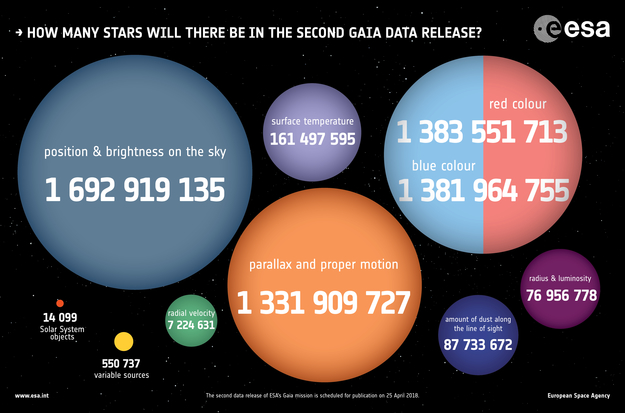 Image: ESA/Gaia
DPAC
Image: ESA/Gaia
DPAC

The new version provides
fast access to the new 1.7 billion stars DR2 catalogue,
new cross-match tables and technical improvements to
prepare the system for future data releases.
Full story
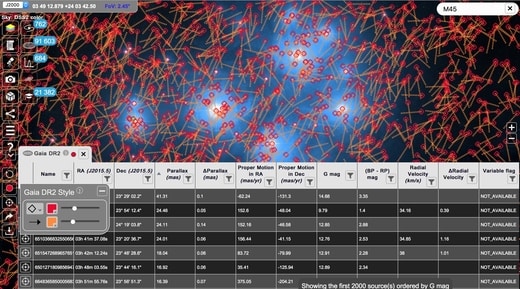
This new minor release includes the main
Gaia DR2 catalogue and other catalogues, new all-sky
maps, and improved features to enhance the user
experience, including the possibility to display proper motion arrows.
Full story

Ulysses was the first mission to study
the Sun at all latitudes. Its data are still extensively
used by heliophysicists.
Full story
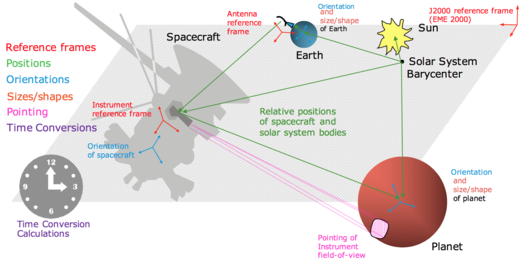
The training will be held at ESAC on June
19-22, 2018, and it is open to all scientists involved
in Solar System exploration.
Full story
The Gaia Science Archive: New
features for DR2
By A. Mora & J. Salgado
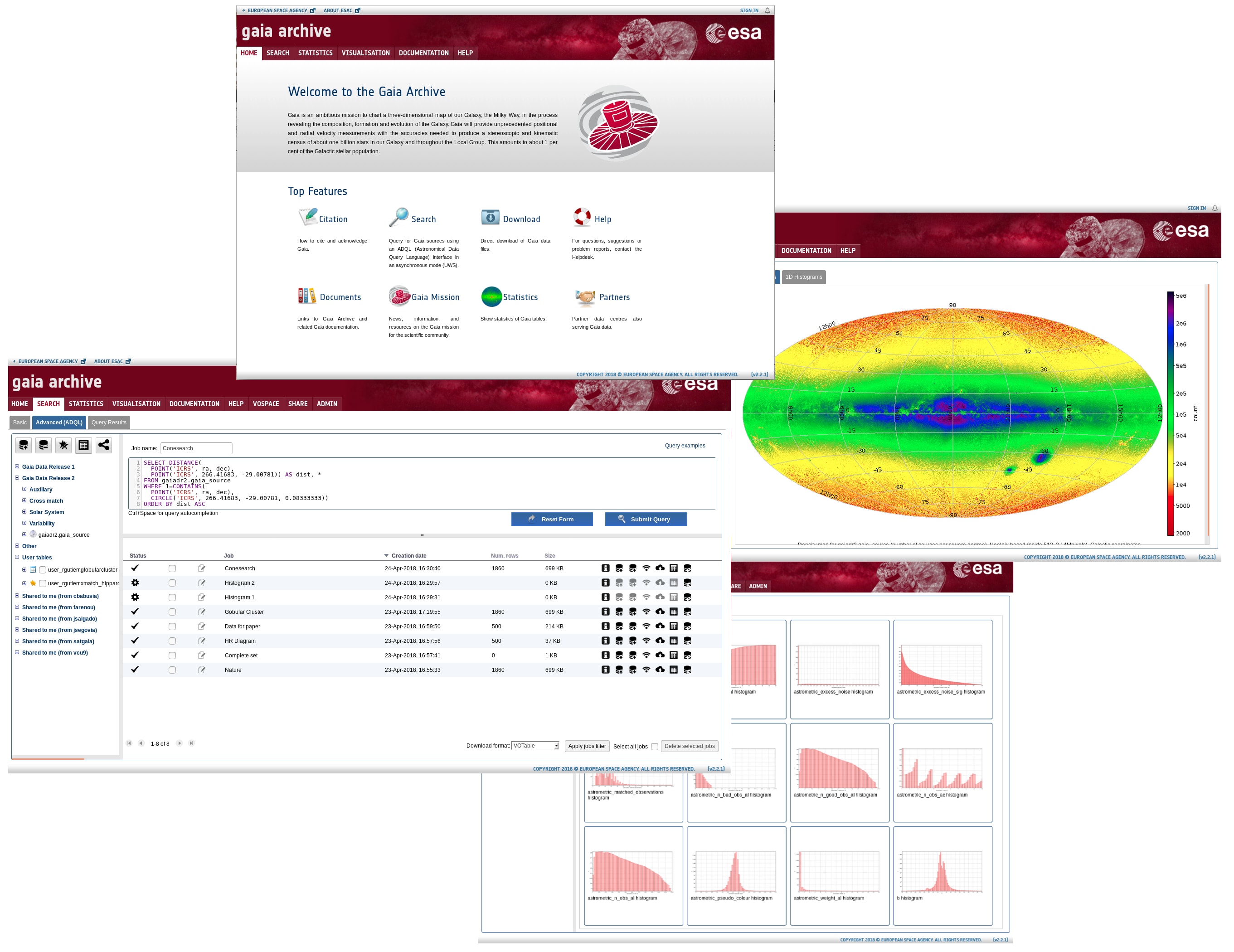 The Gaia
Science Archive keeps for Data Release 2 a balance
between old and new features. The main product is still a
big catalogue (gaia_source), which is accessible using ADQL
queries via the existing TAP interface and different layers
on top for improved usability (Archive GUI, command line
scripts, third party tools such as Topcat, ...). Access to
the previous DR1 is preserved, as well as cross-matches
between DR2 and DR1 and with many of the main astronomical
catalogues (AllWISE, APASS DR9, GSC2.3, Pan-STARRS, PPMXL,
RAVE DR5, SDSS DR9, 2MASS, Tycho-2, etc.). Copies of most of
the external catalogues are also provided to allow easy
metadata combination.
The Gaia
Science Archive keeps for Data Release 2 a balance
between old and new features. The main product is still a
big catalogue (gaia_source), which is accessible using ADQL
queries via the existing TAP interface and different layers
on top for improved usability (Archive GUI, command line
scripts, third party tools such as Topcat, ...). Access to
the previous DR1 is preserved, as well as cross-matches
between DR2 and DR1 and with many of the main astronomical
catalogues (AllWISE, APASS DR9, GSC2.3, Pan-STARRS, PPMXL,
RAVE DR5, SDSS DR9, 2MASS, Tycho-2, etc.). Copies of most of
the external catalogues are also provided to allow easy
metadata combination.
Significant work has been invested to prepare the system for
the upcoming challenges posed by future data releases. The
much larger associated data volumes (by factors up to a
thousand) require the development of novel strategies.
Hardware architecture based on parallel databases will allow
the publication of future Gaia data releases until the final
one (foreseen for around 2022). Two new services have been
introduced, the Virtual Observatory DataLink protocol,
providing an index of the additional resources available for
each source beyond the TAP, and a Massive Data server, which
distributes the light curves for the circa 550,000
identified variable stars. An introductory tutorial is
available in the Help pages.
Other interesting features include routines for rigorous
astrometric epoch propagation (including positions),
statistical plots of the main Gaia catalogue, the novel use
of arrays for a selected subset of variability tables and
the continuity of the popular bulk download server.
One key objective for DR2 is to collect astronomers'
feedback on usability. Please, report to the Helpdesk your findings, specially if
related to the DataLink and Massive Data new services.
Members of the Gaia Archive development team: J. Salgado, J. González, R. Gutiérrez, J.C. Segovia, J. Durán, E. Racero, P. de Teodoro
Image: ESA/ESDC (R. Gutiérrez)
ESASky 2.2: Improved data
exploration functionalities and new data
By B. López Martí

Just in time for Gaia DR2! The newest version
of ESASky not only provides access to the main Gaia DR2
catalogue, but it also offers enhanced data exploration
functionalities.
In particular, for astrometric catalogues, proper motions are
now displayed as vectors. Moreover, to make the displayed
information more easily distinguishable from the background
sky, it is now possible to customise the shape, size and
colour of the catalogue source symbols, as well as the colours
of the footprints from imaging and spectroscopic observations
and the size of the proper motion arrows. Furthermore, the
table tabs in the data panel now include a question mark
symbol that opens a pop-up window with information on the data
and the way they have been integrated in ESASky.
In addition to Gaia DR2, the new datasets provided with this
version are the AllWISE and 2MASS catalogues and a number of
new radio all-sky maps (HiPS). Last but not least, the
publications functionality has been improved for better
usability.
For more information on this release, go to the ESASky documentation pages.
Members of the ESASky development team:
F. Giordano, H. Norman, R. Vallés, E. Racero, D. Baines, M. López Caniego, B. López Martí, P. de Teodoro, B. Merín, J. Salgado
Image: ESA/ESDC
The Ulysses Final Archive: Long-time
preservation of Ulysses unique data
By B. López Martí, B. Martínez &
A. Masson
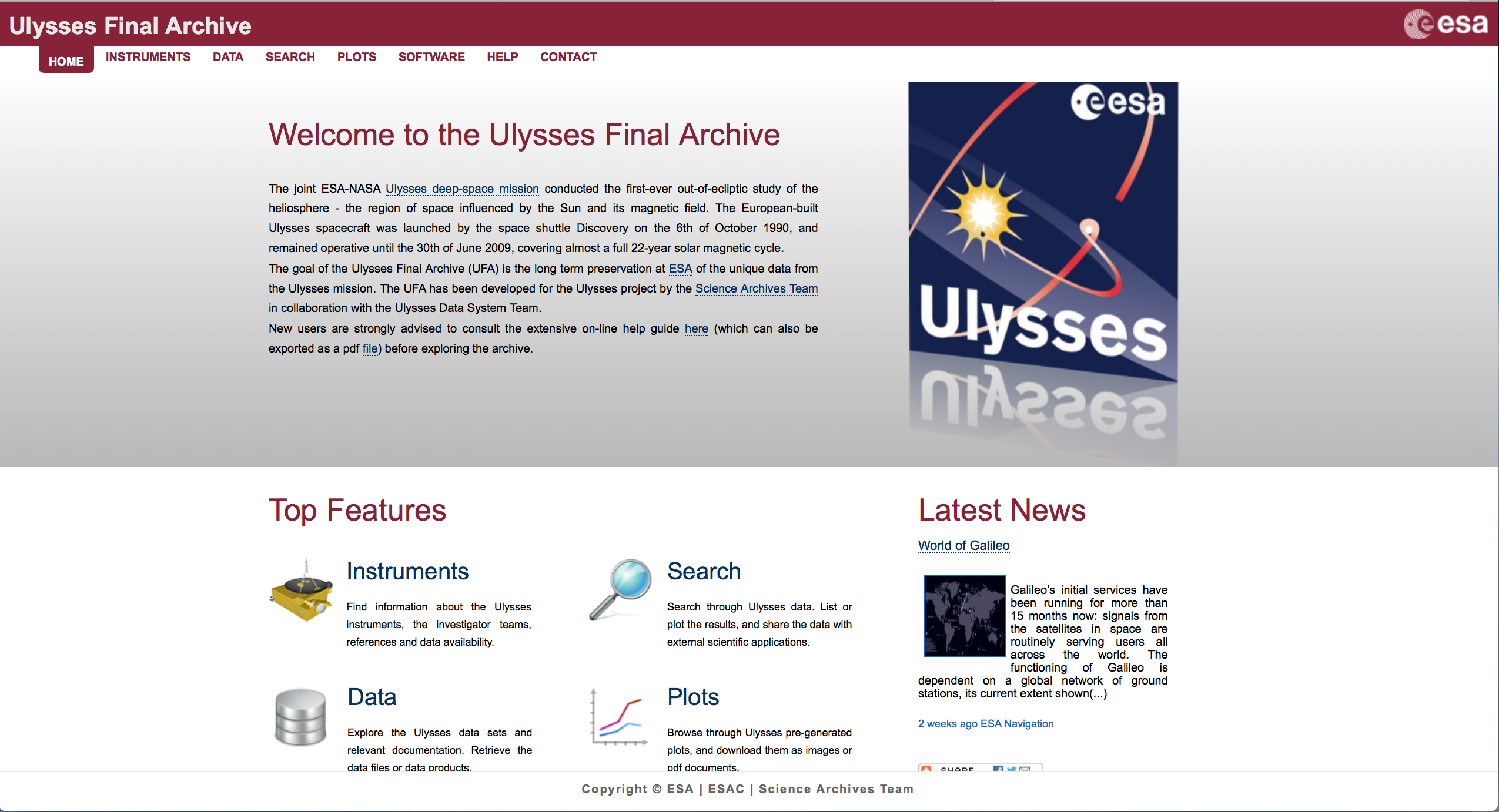
The joint ESA/NASA Ulysses
mission conducted the first out-of-ecliptic study of the
heliosphere, being the first mission to study the Sun at all
latitudes. Operations ceased in June 2009, but its data are
still very valuable for the Heliophysics community.
The Ulysses Final Archive,
whose latest version (1.1.0) was released on March 21, has
been developed by the ESDC in collaboration with the Ulysses
Data System Team with the goal of long-time preserving the
unique data from this mission. The web interface provides
state-of-the-art tools to explore the archive data contents,
pre-generated plots, extended documentation on the instrument
and data, and links to other software resources.
In the last month, the usage of the archive has increased by a
factor of ten, from an average of 30 users per month to more
than 300, a proof of the importance of legacy data for the
scientific community.
Members of the UFA development team:
B. Martínez, A. Masson, H. Pérez, J. Cook, M. Fernández
Image: ESA/ESDC
SPICE training announcement
By M. Costa
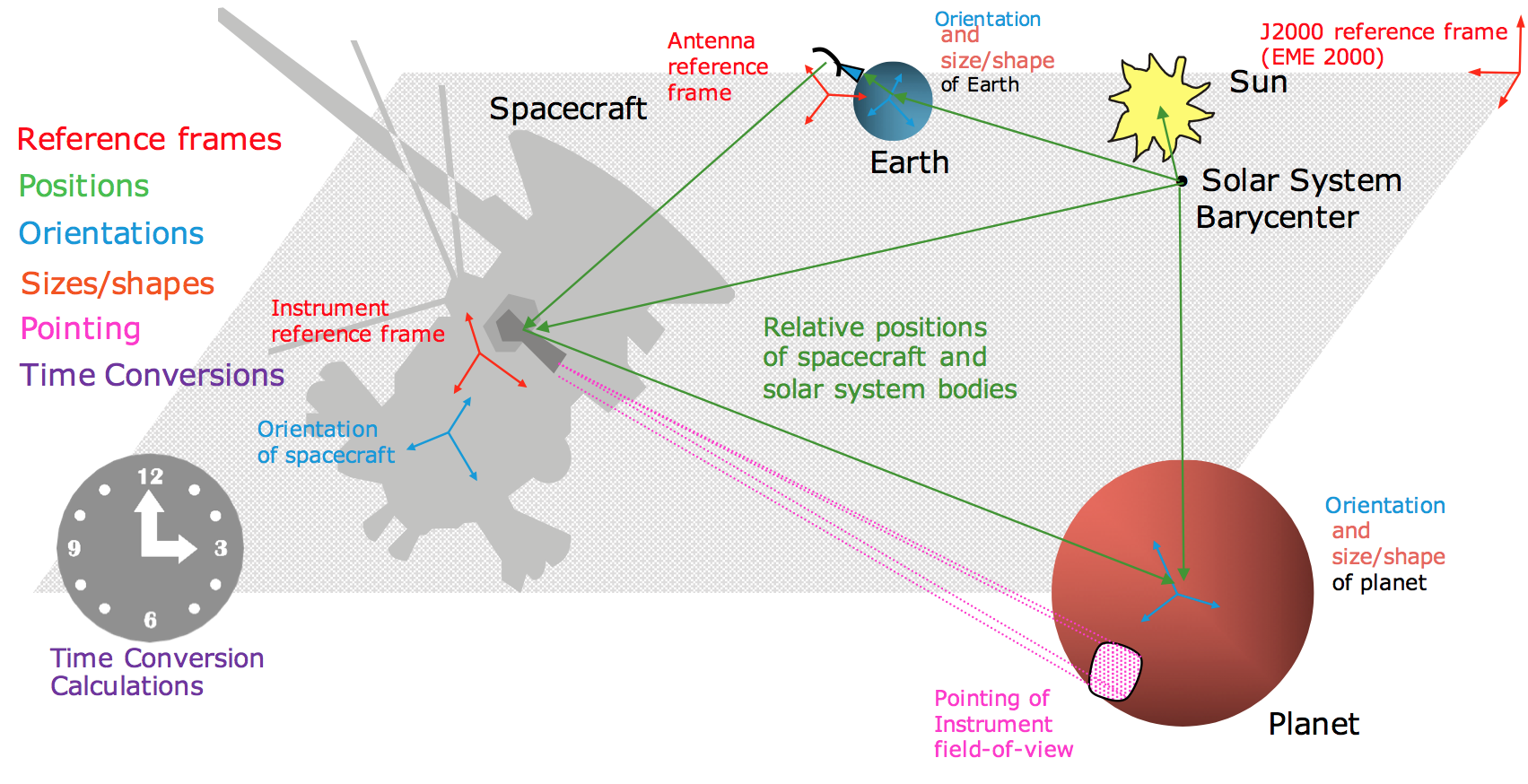
The ESA SPICE Service (ESS) and the
Navigation and Ancillary Information Facility (NAIF) will
conduct a SPICE observation geometry training class on June
19-22, 2018 in Madrid, Spain.
SPICE is an information system the purpose of which is to
provide scientists the observation geometry needed to plan
scientific observations and to analyse the data returned from
those observations. SPICE data are used by all the projects to
generate the geometry parameters for the Planetary Science
Archive (PSA) and is also a Bundle/Dataset that is archived.
For more information, refer to ESA’s SPICE documentation pages.
The class is free and open to all professionals and students
involved in Solar System exploration. Further information
about the class and the class registration form are found at
the training class website. Registration is
due by May 30, 2018.
Image: ESA/ESS


 Image: ESA/Gaia
DPAC
Image: ESA/Gaia
DPAC


 The
The 

